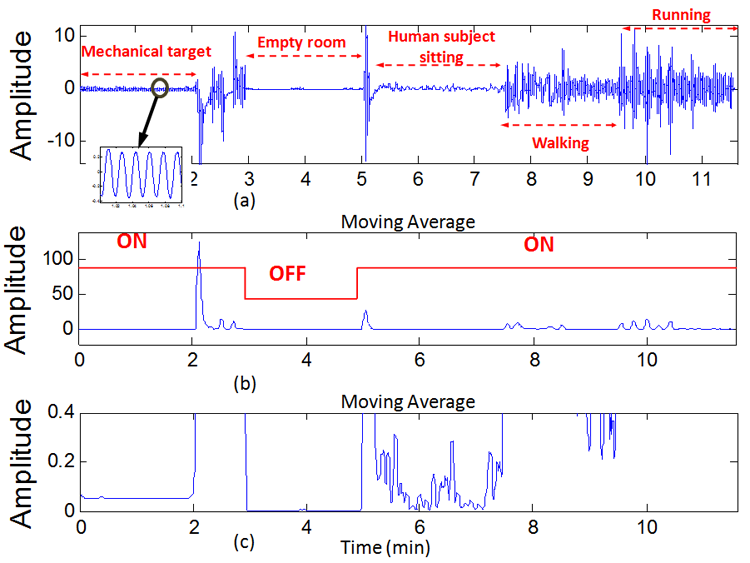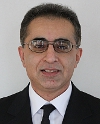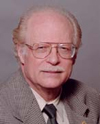True Human Presence Detection with Radar Technology
By Ehsan Yavari, Victor M. Lubecke, and Olga Boric-Lubecke
The main drawbacks of currently available occupancy sensors are high rates of false alarm and failure to detect stationary subjects. The feasibility of true presence is explored with Doppler radar occupancy sensors to overcome the limitations of the common occupancy sensors. Different levels of activity are detected by post-processing sensor signals. Heart and respiratory signals are extracted in order to improve stationary subject detection.
With a projected increase in global energy use of 50% by 2035, mainly from fossil fuels, energy efficiency and conservation are becoming increasingly important. In the US, residential and commercial users account for 42% of total energy consumption [1]. Research has shown that occupancy sensors can save up to 80% of energy used for lighting and HVAC systems, which would also result in significant financial savings. However, currently available occupancy sensors, most commonly passive infrared (PIR) and ultra-sonic (US) sensors, have significant drawbacks which discourage many potential users. These drawbacks include high rates of false alarms when no subject is present, and failure to detect stationary subjects [2]. Thus, these sensors effectively sense motion, not presence. The detection of human cardiopulmonary motion with Doppler radar could provide a promising approach to overcome false trigger and “dead spot” problems associated with conventional occupancy sensors, which may lead to wider adoption and significant energy and cost savings.
While Doppler radar motion sensing systems have been used to detect physiological movement since the 1970s [3], recent reductions in the size and cost of related electronic components have enabled numerous technological advances. These same forces are now making Doppler radar technology feasible for occupancy monitoring applications [4]. In addition, the advent of integrated low-power microprocessor/RF-transceivers provides a new platform to support the combined sensing, processing, and communications needs for wireless intelligent sensor networks in “smart building” systems, including retrofit applications.
The feasibility of a microwave Doppler radar occupancy sensor which can recognize cardiopulmonary motion is illustrated here. This demonstration of a true presence occupancy sensor designed using a commercially available low cost, low power System-on-Chip, has the potential to be applied in practical commercial applications. The sensor measures back scattered electromagnetic signals rather than IR or US signals, and recognizes cardiopulmonary activity as an indication of true presence. The system was tested with a human subject, in the presence of a mechanical target which produced periodic interference similar to that from mechanical appliances like oscillating fans. A 12 minute experiment was performed during which the occupancy sensor was exposed to a range of different presence/interference scenarios [5].
The occupancy sensor system included a 2.4 GHz homodyne Doppler quadrature receiver, with the baseband signals filtered, amplified, and recorded by a data acquisition device. For determination of presence, a short sliding time window was applied across the time-domain data, and the average of the squared signal was then calculated. Fig 1 shows the measured results for the experiment. At first (Fig. 1(a) inset), there is only periodic motion of the mechanical target (1 mm, 1 Hz), which was chosen to be similar to heart and respiration motion to present a significant discrimination challenge.
The spikes between minutes 2 and 3 were due to the changing of targets. Between minutes 3 and 5, the empty room with no motion was recorded. At the end of fifth minute, the human subject entered the room and sat on a chair one meter away from the antenna, followed by no further motion for about two minutes. Finally, the subject began walking in different directions and engaging in high intensity activity (running) until the end of the experiment. The outputs for the moving average and activity detection calculations are depicted in Fig 1(b). When activity was detected, the sensor’s output became positive, which is illustrated by an “ON” decision. Otherwise there was no motion, and the lights and other occupant related loads would be turned “OFF” by the system. On the magnified plot (Fig. 1(c)), the level for the mechanical target motion is constant at 0.05, the empty room is near 0, and respiratory motion of the stationary subject is between 0.01 and 0.31. Setting appropriate thresholds for level and peak widths, and recognizing distinct human motion patterns, makes human presence detection possible throughout the 12-minute interval.

Figure 1: Activity measurement. Five categories of activity were measured over a 12-minute window including: mechanical object periodic movement, empty room, stationary human subject (respiration and heart only), subject walking in various directions, and high intensity activity, (a). The moving average output is shown in (b), with the rectangular red line showing detected activity (on) versus no motion (off), (b). A magnification of the y axis is also shown, (c).
A portion of the input signal between the 6th and 7th minute, when subject is at rest, is illustrated with more detail in Fig 2. Fig. 2(a) illustrates the Doppler radar respiration signal and a chest belt measured reference.
Fig. 2(b) shows the extracted heart signal in good agreement with a finger pulse reference measurement. Fig. 2(c) shows the heart rate calculated by the radar occupancy sensor when the subject was at rest. While human respiration and heart rate are usually thought of as steady patterns, recognizable variations in these cyclical patterns can be used to isolate true human presence form other periodic motion. The radar occupancy sensor can thus readily discern the subject’s measured respiration pattern from the steady periodic motion of the mechanical target. Even in cases of deliberate steady breathing, the sensor can rely on measured heart variability to determine true presence.

Figure 2: View of heart and respiratory signals over a portion of the measurement. The respiratory signal measured with the radar can be seen in (a), compared to a piezo-electric chest belt. The heart activity extracted from the radar signal is shown compared to a finger pulse reference in (b). Heart rate from the radar is compared to the finger pulse reference in (c).
In summary, the accurate detection of true presence has been demonstrated using a low cost low power Doppler radar occupancy sensor, in the presence of interfering mechanical periodic motion which would trigger a false positive in conventional systems. The system also avoids false negatives for stationary human subjects by detecting distinct heart and respiratory rates and patterns. This true presence sensing demonstration illustrates a notable step on the path toward wider adoption of occupancy sensors.
For Further Reading
[1] Annual Energy Outlook 2011 with Projections to 2035, US Energy Information Administration, Independent Statistics and Analysis, http://www.eia.gov/forecasts/aeo/pdf/0383er(2011).pdf [2] M. Levy, “Low-cost occupancy sensor saves energy,” [on line], available at http://www.atmel.com/dyn/resources/prod_documents/mega88_3_04.pdf [3] J.C. Lin, “Non-invasive microwave measurement of respiration,” Proc. IEEE, vol. 63, p. 1530, 1975. [4] E. Yavari, C. Song, V. Lubecke, O. Boric-Lubecke, “System-on-Chip based Doppler radar occupancy sensor,” Engineering in Medicine and Biology Society, EMBC, pp.1913-1916, Aug. 30-Sept. 3 2011 [5] E. Yavari, H. Jou, V. Lubecke, O. Boric-Lubekce, “Doppler Radar Sensor for Occupancy Monitoring,” Radio Wireless Symposium, 20-23 Jan. 2013.






 Nitish V. Thakor is a Professor of Biomedical Engineering at Johns Hopkins University, Baltimore, USA, as well as the Director of the newly formed institute for neurotechnology, SiNAPSE, at the National University of Singapore.
Nitish V. Thakor is a Professor of Biomedical Engineering at Johns Hopkins University, Baltimore, USA, as well as the Director of the newly formed institute for neurotechnology, SiNAPSE, at the National University of Singapore.  J. C. Chiao is a Greene endowed professor and Garrett endowed professor of Electrical Engineering at University of Texas - Arlington...
J. C. Chiao is a Greene endowed professor and Garrett endowed professor of Electrical Engineering at University of Texas - Arlington...  Xu Meng (S'08) received a B.E. degree in electronics and telecomm. in 2006 and a M.S. degree in biomedical engineering in 2008 from the Beijing Institute of Technology...
Xu Meng (S'08) received a B.E. degree in electronics and telecomm. in 2006 and a M.S. degree in biomedical engineering in 2008 from the Beijing Institute of Technology...  D. Kacy Cullen has B.S. and M.S. degrees in mechanical engineering, in 2002, and a Ph.D. degree in biomedical engineering from the Georgia Institute of Technology in Atlanta, GA...
D. Kacy Cullen has B.S. and M.S. degrees in mechanical engineering, in 2002, and a Ph.D. degree in biomedical engineering from the Georgia Institute of Technology in Atlanta, GA...  Mohammad-Reza Tofighi received his B.S.E.E. degree from Sharif University of Technology, Tehran, Iran in 1989, and his M.S.E.E. from Iran University of Science and Technology, Tehran, Iran in 1993.
Mohammad-Reza Tofighi received his B.S.E.E. degree from Sharif University of Technology, Tehran, Iran in 1989, and his M.S.E.E. from Iran University of Science and Technology, Tehran, Iran in 1993.  Arye Rosen received a Masters degree in engineering from Johns Hopkins University, a M.Sc. degree in physiology from Jefferson Medical College, and a Ph.D. degree in electrical engineering from Drexel University...
Arye Rosen received a Masters degree in engineering from Johns Hopkins University, a M.Sc. degree in physiology from Jefferson Medical College, and a Ph.D. degree in electrical engineering from Drexel University...  Walker Turner received B.S. and M.S. degrees in Electrical and Computer Engineering from the University of Florida in 2009 and 2012, respectively.
Walker Turner received B.S. and M.S. degrees in Electrical and Computer Engineering from the University of Florida in 2009 and 2012, respectively.  Dr. Rizwan Bashirullah received a B.S. in Electrical Engineering from the University of Central Florida and M.S. and Ph.D. degrees in Electrical Engineering from North Carolina State University.
Dr. Rizwan Bashirullah received a B.S. in Electrical Engineering from the University of Central Florida and M.S. and Ph.D. degrees in Electrical Engineering from North Carolina State University.  Changzhi Li received a Ph.D. degree in electrical engineering from the University of Florida in 2009.
Changzhi Li received a Ph.D. degree in electrical engineering from the University of Florida in 2009.  Ehsan Yavari received a B.S.E.E. degree from the Ferdowsi University of Mashhad, Mashhad, Iran, and a M.Sc. degree in electronics from Tarbiat Modares University, Tehran, Iran.
Ehsan Yavari received a B.S.E.E. degree from the Ferdowsi University of Mashhad, Mashhad, Iran, and a M.Sc. degree in electronics from Tarbiat Modares University, Tehran, Iran.  Victor M. Lubecke received M.S. and Ph.D. degrees in Electrical Engineering from the California Institute of Technology, and a B.S.E.E. degree from the California State Polytechnic Institute, Pomona.
Victor M. Lubecke received M.S. and Ph.D. degrees in Electrical Engineering from the California Institute of Technology, and a B.S.E.E. degree from the California State Polytechnic Institute, Pomona.  Olga Boric-Lubecke received a M.S. degree from the California Institute of Technology, Pasadena, and a Ph.D. from the University of California at Los Angeles, all in electrical engineering.
Olga Boric-Lubecke received a M.S. degree from the California Institute of Technology, Pasadena, and a Ph.D. from the University of California at Los Angeles, all in electrical engineering.